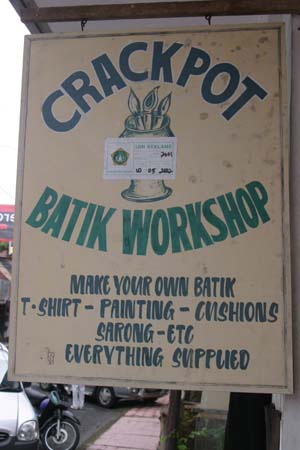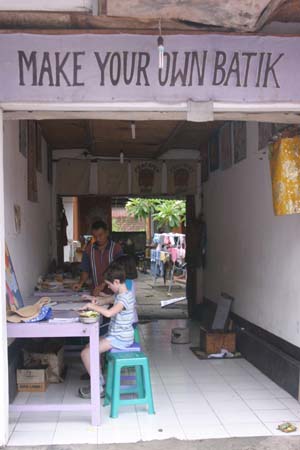The girls were, however, less than excited about our plans. They were quite happy with an endless stretch of days that involved nothing more strenuous than deciding which of the hotel’s three pools to plunge into first, second, and third. They viewed our attempts to inject some interactive, inter-cultural activity as counter to the whole point of a relaxed family vacation. When we told them that the next day we would take an hour-long car ride to Ubud to find something to do that did not involve a pool, a deck of cards, or a book, there was much protesting.
The next morning in Ubud, we walked up and down the small town’s main streets for over an hour, searching out interesting places for hands-on stuff. The girls trailed behind. It must be said that there was whining involved – about the walking, the heat, their parents’ weird ideas of fun, etc.
We first checked out the art museum, which we had been told had excellent hands-on cultural classes. True - but the girls adamantly refused to declare enthusiasm for any of them. “It sounds boring!” “FOUR HOURS to make temple offerings? That’s WAY too long – I don’t wanna!” “Mask-making? Count me out!”
Sighing, we headed for another highly-recommended place, a small community center-cum-lending library. The friendly director had a lot of great-sounded ideas for the girls. When we turned around to ask them whether they’d like to try a Balinese dance lesson, they’d vanished – up the stairs to the library, where we found them both nose-deep in books! Nothing against reading, but not exactly the kind of cultural experience we had in mind.
So you can imagine our surprise when, a little while later, as we were walking down winding, hilly Monkey Forest Road, they both exclaimed, "Ooo! That looks like fun!" We grown-ups did a double-take and quickly back-tracked to a tiny street-side workshop offering make-your-own batik.
 |
The day was suffocatingly hot and humid. If we stood still for more than 30 seconds, especially inside a shop without a whisper of a breeze, we were drenched in perspiration inside of a minute. The friendly proprietor said it would take the kids about two hours to make a batik piece. Two hours sitting still…But the girls seemed genuinely enthusiastic – first time all day - so we signed them up and they set to work. The price - 100,000 rupiah (about $8) a head - was about one-fifth the price of the more formal workshops the girls had rejected. Things were looking up all around! |
| The batik instructor was a nice young guy who had converted the alleyway between Monkey Forest Road and his family's compound into a tiny workshop. The place was heavy with the smell of molten beeswax, and the tools of his craft were everywhere. Every so often, someone would slowly ease a motorbike through the shop on the way in or out of the compound. Other family members on various errands toted kids, baskets, laundry and other stuff to and fro. Nothing formal about this “class”! |  |
The kids didn’t notice any of the goings-on around them, focusing quickly and intently on their projects. The first step was deciding what to paint. After rummaging through a huge pile of patterns, Sami decided to trace a sun-and-moon template, while Miranda forged ahead with her own unique design commemorating our visit.
 |
 |
Next, the teacher stretched a piece of ordinary white cotton sheeting over a homemade light box made of cardboard, scrap wood, and a light bulb. The paper-based design was placed directly underneath the cotton sheet, so the girls could easily trace it with pencil.
 |
 |
Once the design was on the sheet, the girls proceeded to the next step -- applying molten beeswax to each traced line. The teacher was well aware of the potential for dangerous burns, and he was careful to show each girl how to hold the special tool for applying the hot wax. It looked very tricky, and fortunately the teacher encouraged them to practice on a scrap of cloth.
 |
 |
Scattered around his shop were patterns for extremely intricate designs that would have taken hours just to trace; now, seeing the delicacy of the hot-wax process and realizing what a long and tricky task it would be to outline one of these complex patterns, let alone paint in each tiny section, the reasons that batik is so expensive (relatively speaking) became much clearer!
After a fair bit of experimentation by both girls on the scrap piece as well as their own designs, the teacher helped things along, finishing up the hot wax process for them. He made it look simple - but now we knew better.
 |
 |
| Each piece was now ready for color. The teacher had numbered each little pot in his assortment of paints. On the wall hung a corresponding color chart. |  |
| Applying the paint was much more straightforward than the hot-wax process, and the girls quickly got the hang of it. |  |
| The teacher advised them that the colors, when painted onto the cloth, would look pretty different than the finished product - just as glazed clay looks different before and after firing. The significance of the color wheel, featuring the finished hues, was now apparent. Each color decision was enthusiastically discussed and debated. |  |
By now, they girls were more than an hour into the process, and not a whine had been heard! They were having a great time despite constantly wiping the sweat out of their eyes. Their shirts were soaked through. Perched on a stool with a book in hand, I was also hot and sweaty. Sharon checked in now and again between rambles up and down Monkey Forest Road, where she pretended to shop but probably was just ducking into every air-conditioned store she passed.
| After another hour of discussion, decisions, and finally, painting, each piece was ready for the last step – a dip into boiling water to set the color. Fortunately, the teacher offered to do this himself so we could take a break. He told us to come back around five o’clock, about two hours hence, when the colors would be dry enough for us to take the pieces home. We wasted no time in scooting off for a snack and a cool drink. Once refreshed, we strolled through the monkey forest at the bottom of the hill. |  |
Promptly at five, we headed back up the hill to the workshop. The girls’ batiks had come through the boiling process successfully; the wax outlines had melted away and the colors had deepened into jewel-like tones. We were amazed at the transformation, and the girls were proud of their work, enthusiastically thanking their teacher and then posing in his courtyard alongside the drying laundry.

As things turned out, we grown-ups were right: a little hands-on cultural activity did provide a needed change of pace. And the girls were right, too - the two-hour, spontaneous session in the informal workshop ended up being much more fun for them than the high-end museum classes, which took a much more serious “cultural” tone.
And we all experienced one of Bali’s most distinctive characteristics: the notion that art can happen anywhere, and even the most basic materials can, with a little time and inspiration, be transformed into something beautiful.
Next: The Monkey Forest